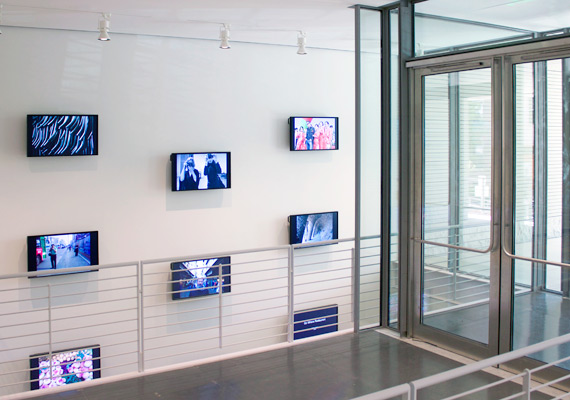“[Photography] . . . is similar to the seemingly truthful—but actually false—state of various kinds of ‘knowledge,’” Chinese artist and activist Ai Weiwei wrote in 2003. “No matter whether or not we are convinced of the information that is presented to us, every bit of it is useless in allaying our doubts.”
That tension between fact and fiction, particularly inherent in 21st-century digital photography, is at the heart of Ai’s 258 Fake, a 2011 work the Harvard Art Museums recently acquired. The installation consists of 12 monitors that display a total of 7,677 digital photographs—most of which were created with smartphones—arranged thematically.
Viewers are confronted with an array of snapshots, from the inane to the deadly serious: the artist giving another man a bowl cut (using an actual bowl), a wide-eyed cat, a plate of food, rubble from Sichuan’s devastating 2008 earthquake. The sheer number and quick rotation of images—each monitor changes every four seconds—reflect both the immediacy and the transience of experiences in the age of digital photography and social media.
Ai created the images between 2003 and 2011 and originally published them on his popular blog. (Chinese authorities shut down the blog in 2011, the same year Ai was arrested on charges of “economic crimes” and detained for 81 days.)
The installation also represents the museums’ commitment to exhibiting contemporary art (nearby is German artist Rebecca Horn’s 2014 installation Flying Books under Black Rain Painting), and to making works more accessible to all audiences. As part of the museums’ new Art in Public Spaces initiative, 258 Fake may be viewed by anyone who enters the building, without having to enter the galleries.
“For me, it’s thrilling to see 258 Fake exhibited,” said Deborah Martin Kao, the museums’ chief curator and the Richard L. Menschel Curator of Photography. “Because the digital photographs are not evenly distributed across the 12 screens, at any given moment the piece presents a unique distribution of images. So there’s an interesting tension between seeing the artwork, experiencing it, and knowing that it will never look exactly the same again.” Kao said Ai provided guidelines for how each monitor should relate to another, and he designed the specific arrangement of the monitors for the installation space.
The work’s title, a nod to the name and address of Ai’s FAKE Design studio in Beijing and a cheeky play on words (the Chinese pronunciation of “fake” is similar to a certain four-letter word in English), also elicits the rhetorical question: if the focus of this work is the “fake,” then what is real?




